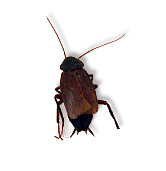General Characteristics:
- These cockroaches are less common than the German cockroach and rarely infest all areas of a structure
- They prefer dark damp areas like drains, crawlspaces, and wet basements
- Adult Oriental cockroaches are primarily black in colour, though some may have a dark reddish brown appearance
- They are 1- 1½ inches in length
- Female roaches can be distinguished by their stunted wings
- While the males do have wings covering ¾ of their abdomens they do not fly
- Generally the females are larger than their male counterparts
Reproduction:
- Oriental cockroach nymphs are ¼ inch in length and are light brown when they hatch. As they mature their colour darkens
- Female Oriental cockroaches produce 8 egg capsules in their lifetime each containing 16 individual eggs
- These are deposited or attached to a protected area near a food source and will hatch in about 60 days
- Depending on environmental conditions it can take anywhere for 2 months to one year to develop into adults
Signs of Infestation:
- These cockroaches are generally found at or below ground level
- They feed on decaying organic matter and garbage
- Cold temperatures can force this species into structure
Control Techniques:
- Eliminating moisture problems and ensuring the inside of drain pipes are not coated in organic build up is essential to control
- Oriental cockroaches can live one month without food but only 2 weeks without water
- As it is quite difficult to limit the food and water source for this species, sealing the structure acts as an effective way to minimize access. PLEASE REMEMBER NOT TO SEAL ANY STRUCTURAL BREATHING HOLES AS THESE ARE NECESSARY FOR THE MOVEMENT OF MOISTURE THROUGH VOID AREAS IN A STRUCTURE.
Please click here to contact a Focus Pest Control professional to inquire about further treatments for this pest species.
References:
Benett, Gary W., et.al.. Truman’s Scientific Guide to Pest Control Operations. Duluth: Advanstar
Communications, 1988. Pp. 132-133, 137-142.
Disclaimer:
The Focus Pest Control ‘Pest Library’ is an educational resource written largely to educate the general public about common pests in Ontario. The Focus ‘Pest Library’ does not include all species in Ontario, nor does it include the most recent scientific data about species we describe. Though we edit our accounts for accuracy, we cannot guarantee all information in those accounts. While Focus Pest Control staff and contributors provide references to books and websites that we believe are reputable, we cannot necessarily endorse the contents of references beyond our control.
(Back to top) |


